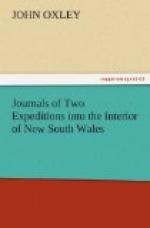June 23.—Having despatched Thomas Thatcher and John Hall to Bathurst, with an account of our progress, the expedition set forward down the river. For four or five miles there was no material change in the general appearance of the country from what it had been on the preceding days, but for the last six miles the land was very considerably lower, interspersed with plains clear of timber, and dry. On the banks it was still lower, and in many parts it was evident that the river floods swept over them, though this did not appear to be universally the case. The far greater part of the last six miles was covered with shrubs, and the acacia pendula. These unfavourable appearances threw a damp upon our hopes, and we feared that our anticipations had been too sanguine. The river continued nearly as before, but much narrower, and more winding, in some measure accounting for the great height of the floods which we observed fifty or sixty miles back, where the river was probably four times as wide: we missed with regret the striking characteristics which had hitherto distinguished it, the sandy and gravelly beaches, and rocky points; though there was certainly the same volume of water which had originally given me such strong hopes that it could never be dissipated over marshes. The banks are no more than twenty feet high in their most elevated places, and the probability is, that all our doubts, speculations, and hopes, will be clearly decided within the week; the soil is of the richest quality, but the flatness of the land, and want of any eminence, are great drawbacks upon the bounties of nature: not but there are numerous spaces above the reach of either land or river flood, which would offer secure retreats to the inhabitants of these singular regions. Several new birds were seen to-day of very beautiful plumage; none however were procured, so as to enable me to describe them. We also saw the crested pigeon, and grey and red parrot of the Lachlan; some fine and singular plants also enriched our collection: it would seem as if nature here delighted in wasting her most beautiful productions upon the “desert air,” rather than placing them in situations where they would become more easily accessible to the researches of science and taste.
June 24.—The country was still extremely flat, and perfectly overrun with acacias, dwarf box (eucalyptus), some species of suffruticore atriplex [See Note at end of this paragraph.], and other shrubs; and intersected by nunumerous extensive lagoons now quite dry, but which when the river is about one-third full, convey the water back over vast plains and levels for the most part clear of every kind of brush, and on the fall of the waters these lagoons act as drains to the lands. The brushes were most numerous and perplexing in the neighbourhood of the river, a course we were obliged to keep, in order not to part company with the boats. The country two or three miles along the banks of the river was only partially




